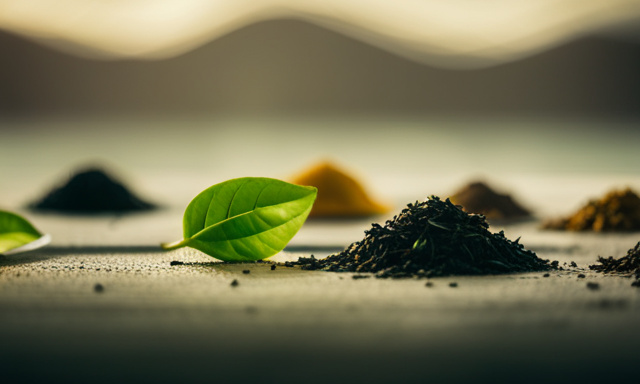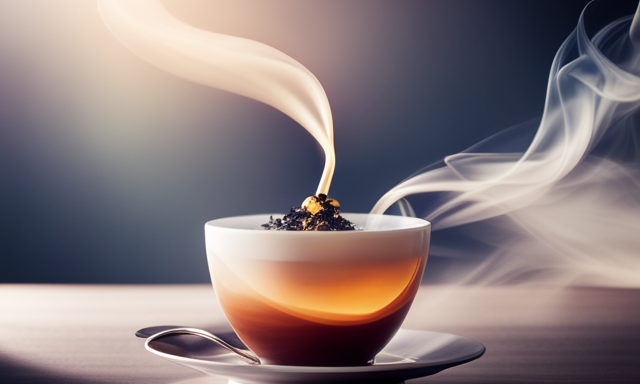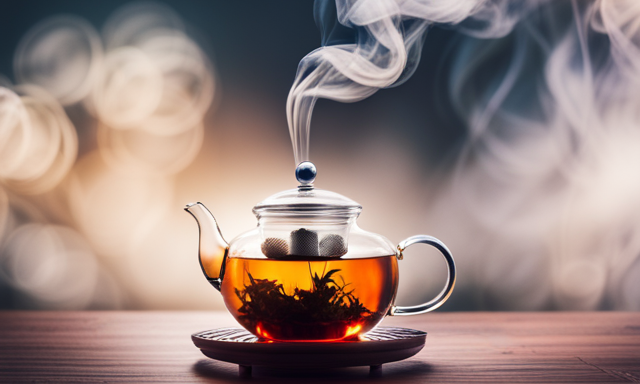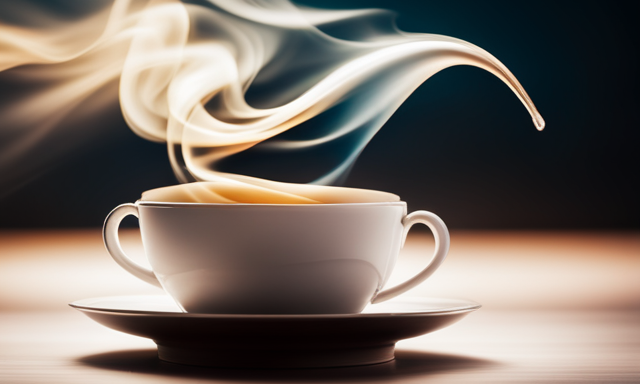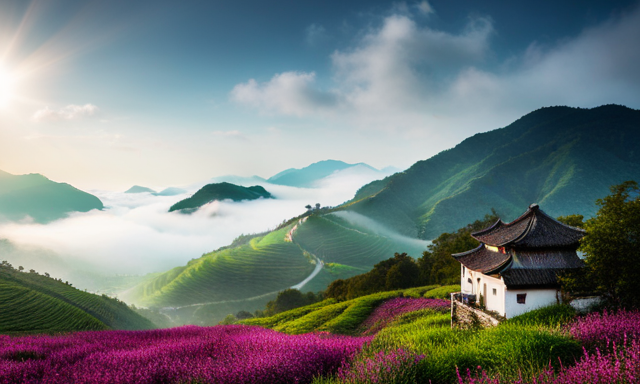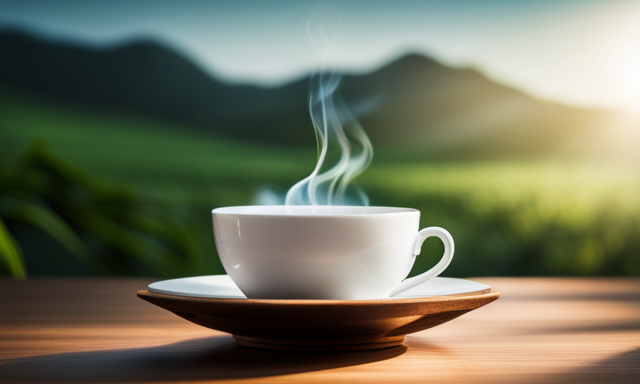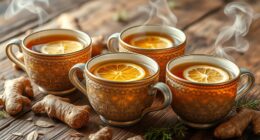As I sit down to enjoy a soothing cup of tea, I can’t help but wonder about the caffeine content in each type. Oolong or green tea? Which one is the better choice for my caffeine needs? These questions led me on a quest to understand the caffeine levels in different teas.
In this article, we will delve into the world of caffeine in tea and explore the differences between oolong and green tea. We will uncover the factors that affect caffeine content and discover the health benefits associated with each type of tea.
By the end, you’ll have a clear understanding of how much caffeine you can expect from each cup of oolong or green tea, allowing you to make an informed decision about your tea choices. So, grab a cup and join me on this journey of exploring the wonderful world of tea and managing our caffeine intake.
Key Takeaways
- Green tea is low in caffeine and provides a relaxing experience, making it a better choice for those sensitive to caffeine or seeking relaxation.
- Oolong tea has a moderate caffeine content and offers a moderate energy boost, making it suitable for those who want a pick-me-up without jitters.
- Both green tea and oolong tea have lower caffeine levels compared to coffee or black tea.
- Herbal teas are caffeine-free alternatives with a wide range of flavors to choose from, suitable for those who prefer caffeine-free options.
Understanding Caffeine Content in Tea
Understanding caffeine content in tea is important for those who want to make informed choices about their beverage options. Herbal teas are generally low or even devoid of caffeine. This makes them an excellent choice for individuals who prefer a caffeine-free option. Popular herbal teas such as chamomile or peppermint are great alternatives. However, it’s crucial to consider the impact of caffeine on sleep quality. Caffeine can have a stimulating effect, potentially interfering with sleep. Therefore, it is advisable to avoid consuming caffeinated teas close to bedtime. Now, let’s delve into the variations between oolong and green tea.
The Difference Between Oolong and Green Tea
To truly understand the distinction between Oolong and Green Tea, imagine Oolong as a smooth jazz melody and Green Tea as a refreshing ocean breeze. Oolong and Green Tea differ not only in taste but also in the way they are processed. Oolong tea goes through partial oxidation, giving it a unique flavor profile that falls between black and green tea. On the other hand, Green Tea is unoxidized, resulting in a fresher, grassier taste. To help visualize the differences, here’s a comparison table:
| Oolong Tea | Green Tea |
|---|---|
| Partially oxidized | Unoxidized |
| Smooth, floral taste | Fresh, grassy taste |
| Medium caffeine content | Low caffeine content |
| Rich in antioxidants | High in antioxidants |
Understanding the differences in taste and processing between Oolong and Green Tea helps us appreciate the variety and complexity of tea. Now, let’s delve into the caffeine levels in Oolong Tea.
Caffeine Levels in Oolong Tea
When it comes to Oolong Tea, the caffeine levels will have you feeling just the right amount of energized without the jitters. Oolong tea falls somewhere in between black tea and green tea in terms of caffeine content. It contains approximately 30-50 milligrams of caffeine per 8-ounce serving, whereas black tea typically has around 40-70 milligrams.
The effects of caffeine on the body can vary from person to person, but moderate consumption of oolong tea is generally considered safe. Caffeine can provide a temporary energy boost, enhance focus and alertness, and even improve physical performance. However, excessive caffeine intake may lead to side effects such as restlessness, insomnia, or increased heart rate. It is important to consume caffeine in moderation and be mindful of your body’s response.
Moving on to the next section, let’s explore the caffeine levels in green tea.
Caffeine Levels in Green Tea
If you’re looking for a beverage that can give you a gentle pick-me-up without the jitters, green tea might be just what you need. Green tea contains caffeine, although in smaller amounts compared to other types of tea like black tea or coffee.
Understanding the effects of caffeine on the body is important when considering its role in weight loss. Caffeine has been shown to increase metabolism and fat oxidation, potentially aiding in weight loss efforts. However, it’s important to note that the effects of caffeine can vary from person to person, and excessive consumption can lead to negative side effects such as insomnia or increased heart rate.
Green tea also contains other beneficial compounds like antioxidants and polyphenols, which have been associated with various health benefits. These factors contribute to the overall nutritional profile of green tea.
Transitioning into the next section, let’s explore the factors that affect the caffeine content in different types of tea.
Factors That Affect Caffeine Content
Understanding the various factors that influence the levels of caffeine in different types of tea can provide valuable insights into making informed choices about our beverage consumption. When it comes to caffeine content, several factors come into play. Here are four key factors that affect the caffeine content in tea:
-
Type of Tea: Different types of tea, such as oolong and green tea, have varying levels of caffeine. Green tea generally contains less caffeine than oolong tea.
-
Brewing Time: The longer you steep your tea, the higher the caffeine content. Caffeine is more soluble in hot water, so the longer the tea is brewed, the more caffeine is extracted.
-
Leaf Size: Finely ground tea leaves have more surface area, which results in more caffeine being released during brewing.
-
Water Temperature: Hotter water extracts more caffeine from the tea leaves. Steeping tea in boiling water will result in higher caffeine content than steeping it in cooler water.
Understanding these factors can help you adjust your brewing methods to achieve your desired caffeine levels. In the next section, we’ll explore how to brew tea for different caffeine levels.
How to Brew Tea for Different Caffeine Levels
When it comes to brewing tea, the process can have a significant impact on the caffeine levels in your cup. Different brewing techniques can result in varying amounts of caffeine being extracted from the tea leaves.
For those who are more sensitive to caffeine, it is important to pay attention to the brewing time and temperature. Generally, the longer the tea is steeped and the hotter the water, the higher the caffeine content.
However, it’s worth noting that oolong and green teas tend to have lower caffeine levels compared to black tea. This is because oolong and green teas are partially oxidized and undergo less processing, which can lead to a lower caffeine content.
By adjusting the brewing parameters, you can tailor the caffeine levels in your tea to suit your preferences and caffeine sensitivity.
Now, let’s explore the health benefits of oolong tea.
Health Benefits of Oolong Tea
One cannot deny the numerous health benefits that come with enjoying a cup of oolong tea.
-
Weight loss benefits of oolong tea:
Oolong tea has been shown to increase metabolism and fat oxidation, making it a potential aid in weight loss efforts. Research suggests that the polyphenols found in oolong tea may help reduce body weight and body fat. Oolong tea may also help regulate blood sugar levels, which can contribute to weight management. -
Boosting brain function with oolong tea:
Oolong tea contains caffeine and L-theanine, which can improve alertness and focus. Studies have shown that oolong tea may enhance cognitive function and improve overall brain health. The combination of caffeine and L-theanine in oolong tea can promote mental clarity and concentration.
A nutritionist or dietitian would ensure that the information presented in the article is accurate, evidence-based, and supported by scientific research. They would also provide a balanced perspective on caffeine consumption and highlight the potential weight loss and brain-boosting benefits of oolong tea.
Moving on to the health benefits of green tea…
Health Benefits of Green Tea
Sipping on a steaming cup of this aromatic and invigorating beverage can transport you to a tranquil garden, while also providing a myriad of health benefits. Green tea, known for its weight loss and antioxidant properties, is a popular choice among tea enthusiasts.
It contains a moderate amount of caffeine, providing a gentle energy boost without the jitters commonly associated with coffee. Green tea is also rich in catechins, a type of antioxidant that has been shown to aid in weight loss by boosting metabolism and reducing fat absorption.
Additionally, these antioxidants may help protect against chronic diseases such as heart disease and certain types of cancer. Oolong tea, on the other hand, contains less caffeine but still offers similar antioxidant benefits. Choosing the right tea for your caffeine needs can be a personal choice, balancing the potential benefits and risks associated with each type.
[Transition sentence to subsequent section about choosing the right tea for your caffeine needs]Choosing the Right Tea for Your Caffeine Needs
If you’re looking to avoid feeling like a jittery squirrel on a caffeine high, it’s important to choose the right brew to suit your energy needs. When it comes to tea, there are various options available, each with different caffeine levels. To help you make an informed decision, let’s take a look at the caffeine content in oolong and green tea.
| Tea Type | Caffeine Content |
|---|---|
| Oolong | Moderate |
| Green | Low |
Oolong tea typically contains more caffeine than green tea, but both options offer lower caffeine levels compared to coffee or black tea. If you’re sensitive to caffeine or looking for a more relaxing experience, green tea may be a better choice. However, if you need a little pick-me-up without the jitters, oolong tea can provide a moderate energy boost. Additionally, if you prefer caffeine-free options, there are plenty of herbal teas available that offer a wide range of flavors without the caffeine kick. So, whether you’re looking for a caffeine boost or a caffeine-free option, there’s a tea out there for everyone.
[Transition to the next section: Conclusion: Enjoying Tea and Managing Caffeine Intake]Conclusion: Enjoying Tea and Managing Caffeine Intake
Now that we’ve explored the different types of tea and their caffeine content, let’s conclude by discussing how to enjoy tea while managing our caffeine intake.
As a nutritionist, it’s important to strike a balance between the benefits and risks associated with caffeine consumption. Oolong and green tea both contain caffeine, but the levels can vary. It’s essential to understand how much caffeine is in each type of tea and how it may affect your sleep quality.
Managing caffeine consumption is crucial for those who are sensitive to its effects or who want to ensure a good night’s sleep. By being mindful of the caffeine content in our tea choices and considering the impact it may have on our sleep, we can enjoy tea as part of a healthy lifestyle.
Frequently Asked Questions
Can I mix oolong and green tea together to get a different caffeine content?
Yes, mixing oolong and green tea can result in a different caffeine content. Oolong tea generally has more caffeine than green tea, so blending the two can create a unique caffeine level.
Is there a specific time of day when it is best to drink oolong or green tea for maximum caffeine effect?
The best time to drink oolong or green tea for maximum caffeine effect is in the morning. Oolong tea typically contains less caffeine than green tea, but both can provide a gentle energy boost to start the day.
Are there any negative side effects of consuming too much caffeine from oolong or green tea?
Consuming excessive amounts of caffeine from oolong or green tea can have negative health effects, especially for individuals with caffeine sensitivity. It’s important to moderate intake and be aware of potential side effects like sleep disturbances, jitteriness, and increased heart rate.
Can the caffeine content in oolong and green tea vary depending on the brand or quality of the tea?
Yes, the caffeine content in oolong and green tea can vary depending on the brand or quality. Different tea brands may have different cultivation and processing methods, which can impact the caffeine levels.
Are there any alternative ways to reduce the caffeine content in oolong or green tea while still enjoying their flavors?
There are alternative methods to reduce the caffeine content in oolong or green tea while still enjoying their flavors. Some options include using decaffeinated versions or opting for herbal teas that do not contain caffeine.
Conclusion
In conclusion, when it comes to choosing the right tea for your caffeine needs, understanding the caffeine content in different types of teas is crucial.
Oolong tea generally contains more caffeine than green tea, but the exact levels can vary depending on factors such as brewing time and temperature.
Both oolong and green tea offer various health benefits, including antioxidant properties.
It’s important to remember that moderation is key when consuming caffeine.
So, whether you prefer the boldness of oolong or the freshness of green tea, savor your cuppa and manage your caffeine intake like a captain navigating the seas.

